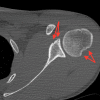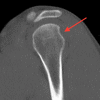Indoor Skydiving: An Emerging Cause of Anterior Shoulder Dislocations
- PMID: 35355644
- PMCID: PMC8929224
- DOI: 10.31486/toj.21.0027
Indoor Skydiving: An Emerging Cause of Anterior Shoulder Dislocations
Abstract
Background: The risks of indoor skydiving have not been extensively studied. Indoor skydiving facilities are often used for corporate events and parties and by relatively inexperienced participants who may not appreciate the risks involved. The abducted and externally rotated shoulder position, combined with nearby walls, tight spaces, and the strong airstream, has resulted in a pattern of shoulder dislocation injuries. Case Report: A 26-year-old male presented with recurrent left shoulder instability after developing an engaging Hill-Sachs lesion following traumatic anterior shoulder dislocation while indoor skydiving. He entered the wind tunnel with his arms abducted and externally rotated. The wind created an upward force that held his arms in this position. As he reached with his left arm for the side of the tunnel to exit, his arm was forced into further external rotation, dislocating the shoulder. The patient was treated arthroscopically with a remplissage procedure and repair of the glenoid labrum. Postoperatively, he resumed his active lifestyle and sports without further dislocations or instability. Conclusion: Indoor skydiving may pose a high risk of anterior dislocation because the shoulder is forced into abduction and external rotation in the free-fall position. We advise caution before participation in indoor skydiving by any individual, but especially those with a history of shoulder instability.
Keywords: Athletic injuries; Bankart lesions; labral injuries; shoulder dislocation.
©2022 by the author(s); Creative Commons Attribution License (CC BY).
Figures






Similar articles
-
Outcomes of arthroscopic Hill-Sachs remplissage and anterior Bankart repair: a retrospective controlled study including ultrasound evaluation of posterior capsulotenodesis and infraspinatus strength assessment.Am J Sports Med. 2015 Feb;43(2):407-14. doi: 10.1177/0363546514559706. Epub 2014 Dec 11. Am J Sports Med. 2015. PMID: 25504843
-
Arthroscopic Bankart repair with and without arthroscopic infraspinatus remplissage in anterior shoulder instability with a Hill-Sachs defect: a randomized controlled trial.J Shoulder Elbow Surg. 2021 Jun;30(6):1288-1298. doi: 10.1016/j.jse.2020.11.013. Epub 2020 Dec 26. J Shoulder Elbow Surg. 2021. PMID: 33373683 Clinical Trial.
-
Arthroscopic Bankart repair combined with remplissage technique for the treatment of anterior shoulder instability with engaging Hill-Sachs lesion: a report of 49 cases with a minimum 2-year follow-up.Am J Sports Med. 2011 Aug;39(8):1640-7. doi: 10.1177/0363546511400018. Epub 2011 Apr 19. Am J Sports Med. 2011. PMID: 21505080
-
Isolated arthroscopic Bankart repair vs. Bankart repair with "remplissage" for anterior shoulder instability with engaging Hill-Sachs lesion: A meta-analysis.Orthop Traumatol Surg Res. 2018 Oct;104(6):803-809. doi: 10.1016/j.otsr.2018.05.011. Epub 2018 Jun 28. Orthop Traumatol Surg Res. 2018. PMID: 29960091 Review.
-
Arthroscopic Bankart repair with remplissage versus Latarjet procedure for management of engaging Hill-Sachs lesions with subcritical glenoid bone loss in traumatic anterior shoulder instability: a systematic review and meta-analysis.J Shoulder Elbow Surg. 2020 Oct;29(10):2163-2174. doi: 10.1016/j.jse.2020.04.032. Epub 2020 Jun 9. J Shoulder Elbow Surg. 2020. PMID: 32807370
References
-
- Shah AA, Selesnick FH. Traumatic shoulder dislocation with combined Bankart lesion and humeral avulsion of the glenohumeral ligament in a professional basketball player: three-year follow-up of surgical stabilization. Arthroscopy. 2010;26(10):1404-1408. doi: 10.1016/j.arthro.2010.03.018 - DOI - PubMed
Publication types
LinkOut - more resources
Full Text Sources
Research Materials
